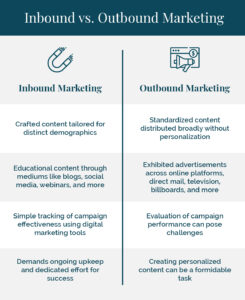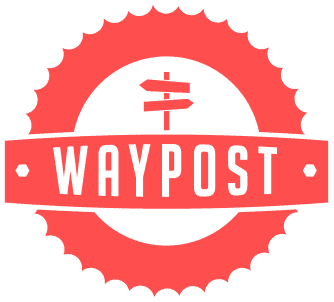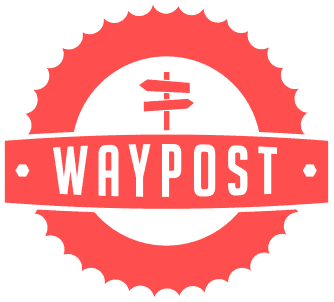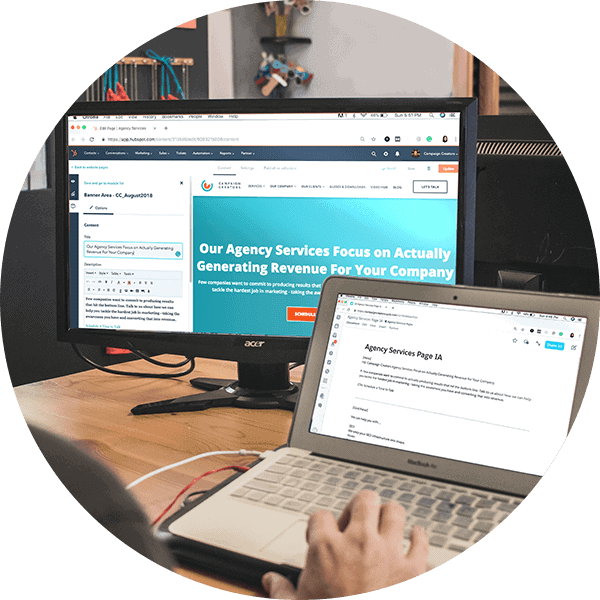
AI for SEO—Can ChatGPT Really Improve Your Google Ranking?
January 2, 2024
Avoid Clickbaits: Marketing Analytics Scam Emails
March 7, 2024As a business leader, strategically allocating marketing dollars is a pivotal choice that demands your attention. You’ve probably encountered buzzwords like “outbound marketing” and “inbound marketing.” However, given that marketing might not be your core expertise, fully understanding the meaning of these terms might not have been a priority, leaving you with the dilemma of how to use the marketing budget in the most effective and revenue-generating way.
So what is the difference between inbound vs. outbound marketing? Allow us to explain:
What Is Outbound Marketing Exactly?
 To better understand what outbound marketing is, picture this: You’re relaxing on your sofa after a tiring day, yearning for some relaxation, hoping to set aside the day’s problems and commitments, and simply unwind while watching TV. Suddenly, a TV ad intrudes, interrupting your downtime.
To better understand what outbound marketing is, picture this: You’re relaxing on your sofa after a tiring day, yearning for some relaxation, hoping to set aside the day’s problems and commitments, and simply unwind while watching TV. Suddenly, a TV ad intrudes, interrupting your downtime.
Obviously, we created a slightly “exaggerated” scenario to make a point, but the concept still holds true. Outbound marketing, oftentime referred to as “interruption marketing”, is a marketing approach that “pushes” marketing messages at your audience. In this particular scenario, there’s less emphasis on personalization, segmentation, or even considering the audience’s stage at the marketing funnel. The notion here is that marketing messages are spread in a less targeted manner. Outbound marketing strategies include TV commercials, radio spots, newspaper ads, and flyers, to name a few.
But Commercials Are Everywhere, So — Where’s The Problem?
It’s important to acknowledge that not all traditional, outbound marketing channels are obnoxious or interrupting to that degree. In fact, most of them aren’t. Outbound marketing strategies can sometimes yield good returns on investment, and they certainly contribute to strong brand recognition, which pays off both in the short and long run.
There are two primary problems though with unmindful outbound marketing:
- Outbound marketing reaches your audience when they are not necessarily ready yet
Upon seeing the ad (for instance, on TV or a billboard), your audience may not be actively seeking to resolve a problem. They might not even be aware they have a problem. So, even though your ad grabs their attention, it may soon be forgotten without spurring action, simply because they are not ready for you. Your product or service isn’t on their radar yet.
- Extensive reach isn’t always effective
When you broadcast a TV ad, it is shown to everyone tuned in during prime-time TV. Your billboard is being seen by everyone driving down the highway, and your printed-out flyers are distributed to all residents in the apartment complex. This extensive reach might seem effective, but it isn’t, because the recipients of these messages might not truly require your product or service (or wish to receive messages from you).
Can You Take the Good of Outbound Marketing Without the Bad?
In a nutshell, outbound marketing is a great way to instill brand recognition in the minds of the masses. However, its inherent “intrusive” or “annoying” nature somewhat contradicts its intended goals. That being the case, marketers face the challenge of developing a new marketing strategy that capitalizes on the upsides of outbound marketing while mitigating its downsides; A strategy that harnesses the positive elements of outbound marketing while concurrently incorporating elements that offset its drawbacks.

Inbound Marketing — The Mirror Image of Outbound Marketing
What if, rather than blindly advertising to a broad audience, you could target and engage those actively exploring solutions to their problems? What if you catch them at the beginning of their search, provide valuable information early on about the nature of their problem and available solutions, and position your business as the best remedy?
This more personal marketing approach forms the bedrock of inbound marketing. Often referred to as permission-based marketing, it allows you to connect with motivated prospects when they’re most receptive to your message. It allows marketing exclusively to people who are already looking for solutions you can provide.
Inbound marketing is the mirror image of outbound marketing, offering advantages precisely where outbound marketing falls short:
- You are not wasting money on people who don’t need you.
- You can generate leads and capture people from the beginning of their buying process instead of stumbling in somewhere near or at the end.
- You can track exactly where your strategies are working and where they aren’t, and adjust accordingly.
- You can measure your website visitor worth to assess how much revenue is coming from your website.
- You can build your brand engagement by being authentic and talking to your target market where they are.
The bottom line is this: Inbound marketing says “I do not want to market to you if you do not want to be marketed to.” It is the principle of quality over quantity; It is permissive rather than interruptive; It is customer-centric rather than market-centric.
Prominent inbound marketing avenues encompass blogging and content marketing, social media marketing, targeted advertising, email marketing, and more.
Inbound vs. Outbound Marketing — Which One is A Better Way to Market?
The answer is “Both”. Outbound and inbound marketing, both have their own unique strengths, and you definitely shouldn’t miss out on any. With outbound marketing, you leverage wider exposure as part of your overall brand recognition. With inbound marketing, you leverage more targeted marketing that resonates with your customers specifically. And who says that you can’t enjoy the best of both worlds?
The ideal blend of inbound and outbound marketing methods will be determined by establishing a unified, cohesive marketing strategy that helps you extract the maximum benefits from each.
Start by setting business goals and analyzing your target audience and resources. Then, craft an integrated strategy using outbound tactics like advertising and PR to increase awareness, while leveraging inbound marketing through content, SEO, and social media to nurture leads. Striking the optimal balance between outbound and inbound approaches can help you achieve brand visibility along with qualified, loyal customers over time.
If this is sounding like something you’d like to talk more about, give us a call at (864) 288-6162 or contact us online to set up a chat.








